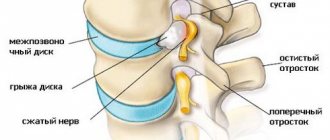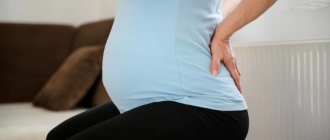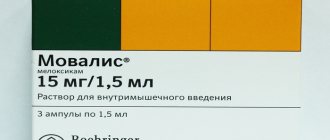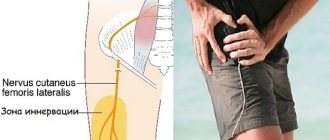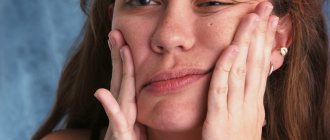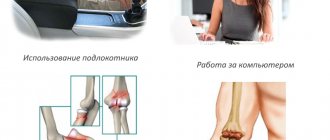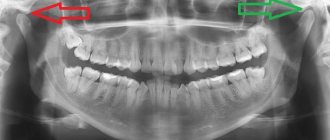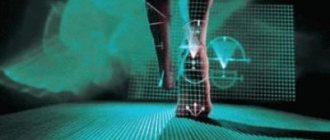Neuropathy of the pudendal nerve
Definition:
Pudendal nerve neuropathy, also known as “Pudendal neuralgia”, “Pudendal canal syndrome”, “Alcock canal syndrome”, “Pudendal nerve compression syndrome”, “Tunnel pudendopathy” is a fairly common but rarely diagnosed disease .
Symptoms : pain in the perineum, genitals, anus. Like all types of neuropathic pain, this pain is characterized by a burning sensation, tingling, or “pins and needles.” of a foreign body in the rectum , vagina and/or urethra is quite common
In addition to these symptoms, there may be: urinary or fecal incontinence, with sexual dysfunction . The pain intensifies when sitting. In women, symptoms of pudendal neuralgia include pain (burning, itching, tingling) in the clitoris, pubis, vulva, lower 1/3 of the vagina and labia.
The skin in these areas may be hypersensitive to touch and pressure (hyperesthesia and allodynia).
Possible symptoms also include burning, numbness, increased sensitivity, electrical or knife sensation, aching pain, sensation of a lump or foreign body in the vagina or rectum, a feeling of twisting or constriction, abnormal temperature sensations, a “hot poker” sensation, constipation, pain and difficulty defecating, difficulty or burning when urinating, pain during intercourse, and sexual dysfunction - loss of sensation in the clitoris and/or the anterior third of the vagina.
Diagnostic criteria for pudendal nerve neuropathy:
Main criteria –
- Pain (burning, itching) in the area of three branches of the pudendal nerve (clitoris, anus, vestibule of the vagina)
- Neuropathic nature of pain (burning, itching, tingling, goosebumps, hypersensitivity or loss of sensitivity)
- Effect of pudendal nerve block (pain reduction for 12 – 36 hours)
- A decrease in blood flow velocity in the pudendal artery, which is determined during Doppler ultrasound scanning. Since the pudendal artery passes along with the pudendal nerve in Alcock's canal, processes leading to compression of the pudendal nerve also lead to compression of the pudendal artery.
Anatomy of the pudendal nerve ( nervus pudendus , pudendal nerve ):
The pudendal nerve leaves the spinal cord at the level of the 2nd, 3rd, and 4th sacral vertebrae (S2-S4), leaves the pelvic cavity through the greater sciatic foramen, and then returns to the small pelvis through the piriformis foramen, under the piriformis muscle. The piriformis muscle can cause compression (squeezing) of the pudendal nerve in myofascial syndrome (piriformis syndrome) .
In the pelvic cavity, the pudendal nerve passes through Alcock's canal, where it can also be compressed by the sacrospinal ligament.
Further, it is divided into three branches:
- Rectal nerve
- Perineal nerve
- Clitoral nerve
That is why symptoms of pudendal nerve neuropathy appear in the anus , perineum and external genitalia.
Interactive atlas of pelvic anatomy (link)
Causes of pudendal nerve neuropathy:
- Obstetric neuropathy - damage to the pudendal nerve during childbirth, sometimes the obturator nerve suffers along with it
- Myofascial syndromes – hypertonicity of the piriformis muscle can cause compression of the pudendal nerve in the foramen infrapiriformis. In addition, compression of the pudendal nerve may be caused by spasm of the obturator internus or levator ani muscles.
- Traumatic neuropathy – caused by chronic trauma (riding a bicycle or horse) or a fracture of the pelvic bones.
- Compression of the pudendal nerve in Alcock's canal
Diagnosis of pudendal nerve neuropathy:
The diagnosis is made based on the so-called diagnostic criteria (Aix-en-Provence diagnostic criteria):
- Localization of pain (one or more branches of the pudendal nerve - usually on one side)
- Nature of the pain (burning, goosebumps, tingling, sensation of electric shock)
- Increased pain when sitting
- Reducing pain in the lying position
- Unilateral nature of the pain
- Positive effects of cold
- Injecting an anesthetic into the area of the pudendal nerve reduces pain for 12 hours or more
- Ultrasound examination of the Alcock canal with determination of the speed of blood flow in the pudendal artery allows us to suspect compression of the pudendal nerve when the speed of blood flow in the artery decreases - since they pass together in this canal.
Treatment:
Treatment must be comprehensive:
- Drugs affecting neuropathic and chronic pain (Lyrica, Tebantin)
- Physiotherapy
- Pudendal nerve blocks with anesthetics and glucocorticoids
- Surgery – decompression of the pudendal nerve
- Neuromodulation
Remember that the duration of treatment is at least 6 months.
In the field of diagnosis and treatment of pudendal neuralgia , we work closely with Prof. Eric Botrand , one of the world's leading specialists in the treatment of chronic pelvic pain, who regularly consults in our clinic. Professor Botran's next visit will take place in December 2014.
In our clinic we use all modern treatment methods.
We are the only clinic in Russia where operations on decompression of the pudendal nerve .
Contact us and we will do our best to help you!!!
Patients from other cities believe that treatment in our clinic is long and therefore difficult for them to come to us! Sometimes this is true, but in most cases one day is enough for diagnosis.
The next day, an injection of botulinum toxin, cryoneurolysis of the pudendal nerve, decompression of the pudendal nerve, TVT surgery are performed - in general, the most effective manipulations for the treatment of chronic pelvic pain syndrome and urinary disorders.
Patients can continue treatment at home - under our close supervision via Skype, email, etc. We provide all necessary medications and (if necessary) devices for home physiotherapy.
Source: https://uro-ginecology.ru/uslugi-kliniki/lechenie-hronicheskoy-tazovoy-boli/neyropatiya-polovogo-sramnogo-nerva
Long-term treatment
It must be remembered that treatment of neuropathy of the pudendal nerve is a very long process, during which all recommendations of the attending physician should be followed. The recovery period takes at least six months.
Treatment of the disease should be carried out only in a hospital setting, as this will allow doctors to take control of the healing process, as well as successfully select a set of means that will be used for proper treatment. After all, a person may be allergic to some medications, which will only worsen the situation.
Pudendal nerve and entrapment, genitofemoral nerve neuropathy
There are many nerve pathways in the human body, each of which innervates a specific area. Among them we can distinguish the pudendal nerve, which in medicine is called the genital nerve.
It is responsible for the innervation of the pelvic floor muscles, and when this bundle is pinched, people experience chronic pain in the pelvic area. This phenomenon usually occurs due to compressive neuropathy. It represents compression (pinched nerve).
In men, this problem occurs 2-3 times more often than in women due to anatomical features.
Features of the anatomy of the pudendal nerve
The pudendal nerve tract begins significantly above the innervated zones, which is why doctors often call it the femoral-genital nerve. It passes through the muscles of the lower back and over the ureter, and then extends to the groin area. At this point it is divided into 2 branches:
- Femoral;
- Inguinal (genital).
The femoral-genital nerve, passing into the inguinal branch, has 2 options for continuation depending on the gender of the person:
- Male. It exits through the canal along with the spermatic cord and follows into the scrotum;
- Female. In the case of the weaker sex, the pudendal nerve leaves the canal along with the round ligament of the uterus and smoothly passes into the skin of the labia majora.
The inguinal nerve in women and men innervates the following tissues:
- Muscle tissue of the anus;
- The outer skin of the anus and genitals;
- Anal sphincter;
- Musculature of the perineum;
- Female clitoris;
- Male cavernous bodies of the penis;
- Bladder sphincter.
The pudendal nerve tract is responsible not only for the sensations experienced during sexual intercourse, but also directly for defecation and urination.
It performs the last two functions thanks to the vegetative fibers in its composition. It is the autonomous (vegetative) part of the nervous system that is responsible for many systems that are not controlled by human consciousness, for example, constriction of the pupils, heart rhythm, etc.
Damage to this nerve is caused by pinching of the piriformis muscle, ligaments, etc. Sometimes the cause of such compression lies in the injury received, as a result of which the pelvic bones were crushed or ligaments were torn. This type of neuralgia is usually accompanied by a feeling of tension and inflammation.
Causes of inflammation
Traction-compression neuropathy of the left or right nerve tract occurs in the Alcock canal. Therefore, pinching of the pudendal nerve that occurs in this area is called Alcock syndrome.
Among other types of neuropathy characteristic of this nerve pathway, one can distinguish the femoral-genital form. It manifests itself mainly due to groin injury or the development of an inguinal hernia. Ilioinguinal nerve neuropathy also falls into this group.
It occurs due to the appearance of scars on muscle tissue, which are a consequence of surgery.
Pinching of the pudendal nerve occurs mainly due to the following factors:
- Trauma sustained during childbirth;
- Spasm of the muscle tissue of the anus;
- Pelvic fracture;
- Development of malignant oncological diseases;
- High tone of the piriformis muscle;
- Complications of herpes;
- Spasm of the obturator internus muscle;
- Compression of the pudenda due to riding a horse or bicycle.
Symptoms
Compressive neuropathy of the pudendal nerve is characterized by many symptoms, but their severity is rather mild. For this reason, it is extremely difficult to diagnose pathology. Among the main manifestations of the disease are the following:
- Aching pain in the pelvic area;
- Genital dysfunction;
- Constant feeling of discomfort in the anal area;
- Involuntary urination;
- False sensation of a foreign object in the groin area;
- Feeling of burning and slight tingling in the groin area;
- Excessively high sensitivity of the skin in the groin area.
In women, severe itching and burning in the genital area can be added to the main symptoms of neuropathy. In a sitting position, these symptoms intensify significantly.
In more rare cases, the following symptoms are observed:
- Abnormal bowel movements (constipation);
- Numbness of the genitals;
- Pain during sexual intercourse and when urinating.
Diagnostics
The doctor identifies the presence of a problem, focusing on the symptoms and ultrasound results. In case of neuropathy, it will indicate impaired blood flow in the pudendal artery, which passes through the Alcock canal. From this we can conclude that along with it there was compression of the pudendal nerve tract.
An effective diagnostic method is blockade of the pudendal nerve tract. If the discomfort disappears, then all the blame lies with neuropathy. Typically, in such a situation, a course of therapy is prescribed, which includes glucocorticoid injections, vaginal suppositories and other methods of restoring pinched nerve fibers.
Course of therapy
Treatment of neuropathy should consist of a set of measures aimed at eliminating inflammation, relieving pain and restoring nerve conduction. Typically it includes the following treatment methods:
- Elimination of pain with the help of anticonvulsants (Gebapentin);
- The use of physiotherapeutic procedures (phonopharesis, electropheresis, etc.);
- Blocking the nerve pathway with a solution of hormones and anesthetics;
- Use of muscle relaxants (Mydocalm);
- The use of vitamin complexes (Neuromultivit).
Neuromultivit vitamins and their analogues can be taken both as a component of a blockade solution and in the form of tablets. If the discomfort is severe, then suppositories for rectal or vaginal use based on Diazepam and special sets of exercises are used. The essence of physical therapy for neuropathy of the pudendal nerve is to compress and relax the muscles of the perineum.
If there is no point in continuing to treat medically damaged nerve tissue due to lack of results, then surgery will be required to decompress the compressed nerve. Such operations are extremely effective, but have a long recovery period.
With prolonged absence of treatment, the consequences of the pathology may develop. The disease can become chronic and some symptoms will be extremely difficult to eliminate. There have been cases of impotence and decreased libido, as well as increased involuntary urination and defecation.
Pudendal neuropathy is an unpleasant condition, but some people live with it for years. This is usually associated with vague symptoms and a chronic course. You can avoid such discomfort, but to do this you will have to undergo an examination and follow all the doctor’s recommendations.
Source: https://NashiNervy.ru/perifericheskaya-nervnaya-sistema/ushhemlenie-sramnogo-ili-bedrenno-polovogo-nerva.html
Results
Thus, it was discussed what the pudendal nerve is, symptoms and treatment for its pinching, and diagnosis. In order to avoid this disease, it is recommended to be careful and avoid injury, as well as to lead an active lifestyle, exercise and have an active sex life. Well, if trouble does happen, then you must strictly follow the doctors’ recommendations.
Damage to the pudendal (genital) nerve often causes chronic pain in adults, localized in the pelvic area. In men, this pathology occurs three times less often than in women. The anatomy of the pudendal nerve can explain this phenomenon.
Pudendal nerve and entrapment: neuropathy of the genitofemoral nerve
Yes, the nature of the pathology is different in that the pudendal nerve serves the pudendal area - the genital area, the structure of which is different in men and women. The words of one very concentrated boy from the film “Kindergarten Policeman” immediately come to mind, with which he stopped everyone entering the door of the kindergarten: boys have a penis, girls have a vagina.
In men, the concept of external genitalia includes much more structures in terms of number, volume, and area, therefore the pudendal nerve has a more complex and branched structure, while in women, due to the greater “compactness” of the external genitalia, its length is much shorter.
The pudendal nerve is a paired structure formed on both sides of the body also by the paired branches of the sacral spinal nerves, which provides innervation to organs present in both sexes: the perineum, sphincters of the bladder and rectum, as well as the levator ani muscle, but then they begin differences in structure: in women it provides sensitivity and vegetative function of the labia majora and minora and the clitoris, in men it provides the same functions in relation to the cavernous bodies of the penis and scrotum.
In the photo, the same painful area in women is highlighted in yellow.
About the causes and symptoms of functional disorders
For the etiology of damage, the proximity to the ischium, which the nerve goes around entering the pelvic cavity, as well as the relatively shallow depth of the terminal branches under the surface of the skin and mucous membranes of the pelvic organs, are important. Therefore, dysfunction can occur as a result of:
- injuries to the perineal area; Trauma to the perineum can lead to more severe consequences
- hypothermia of the perineal area;
- pressing against the ischium by the piriformis muscle due to the presence of a volumetric process in the small pelvis, or due to compression between the pelvic ligaments, or due to another reason;
- damage to the formations that make up the sacral plexus or the sacrum itself.
Provoking factors may be:
- horse riding or cycling (frequently or professionally);
- prolonged labor;
- fracture of the pelvic bones (from a fall from a height, in a car or plane accident).
To understand that something is wrong with the genitofemoral nerve is made possible by dysfunctions of the organs located in the pelvis. These may be sensitivity disorders or autonomic disorders.
The first category includes both varying degrees of decrease in sensitivity (up to its complete loss) and an increase in pain to unbearable limits.
Deviations in autonomics are expressed by disturbances in the functioning of glands and other structures containing smooth muscle fibers, in particular, disorders of the mechanism of blood supply to the cavernous bodies of the penis or clitoris.
Trophic disorders of the skin of the perineum, scrotum and peri-anal area can also be a sign of disorders.
In addition to physical factors, the cause of pathology can also be general somatic diseases:
- tuberculosis;
- collagenoses;
- blood supply disorders due to endocrine disorders and vascular accidents or for any other reason.
Infringement of rights, or neuralgia
It has long been noticed that those who are violated in their rights either scream loudly about this fact, or mutter about it in a low voice until no one hears.
Provoking factors
The situation is exactly the same if the pudendal nerve is pinched in the canal containing it. A canal with a narrowed diameter for some reason (due to bone growths, bone fractures, or for some other reason) puts pressure on the nerve, which leads to predominantly pain of varying intensity.
Compression of the nerve can be caused by its “swelling”, accompanied by an increase in diameter, which causes its discrepancy with the diameter of the enclosing canal.
But the structure of the affected pudendal nerve does not change during neuralgia. Movement disorders do not occur in the same way as loss of sensitivity.
Therefore, neuralgia is exclusively pain of varying nature and intensity.
And pinching of the pudendal nerve can occur in the inguinal canal:
- with varicose veins of the spermatic cord in men;
- due to pathology of the round ligament of the uterus in women;
- due to an inguinal hernia or the occurrence of cicatricial changes after hernia repair.
Pelvic neuralgia, which often accompanies pinched pudendal nerve, can also occur due to:
- trauma during childbirth;
- muscle spasm in the area of the anus, hypertonicity of the piriformis muscle or obturator internus muscle;
- development of oncopathology in the pelvic organs;
- the onset of complications of herpes.
Features of symptoms
Symptoms of this form of neuralgia are chronic pain in the pelvic area, having the following character:
- aching;
- feelings of burning and itching, especially strong in women and especially in a sitting position;
- excessively high sensitivity of the skin of the groin and perineum area;
- sensations of constant discomfort in the area of natural orifices of the body;
- false-obsessive sensation of a foreign body in the genital area.
Against the background of chronic stress, the following sensations may appear from long-term sensations:
- urinary disorders (involuntary act) or pain when urinating;
- dysfunction of the genital organs (pain during coitus);
- bowel disorders (constipation).
Diagnostic criteria and treatment
For diagnosis, symptoms are important - the patient’s sensations, as well as the absence of external manifestations of pathology.
The use of:
- Ultrasound;
- blockade of the pudendal nerve tract.
In the first case, a violation of blood flow through the pudendal artery is detected, in the second - the disappearance of discomfort after manipulation.
The main goals of treatment are: pain relief, elimination of inflammation and restoration of nerve conduction.
Therefore, it is advisable to use:
- anticonvulsants (Gabapentin), which provide pain relief;
- muscle relaxants (Mydocalm), used to relax muscles;
- blockade of the pudendal nerve with a combination of solutions of anesthetics and hormones;
- vitamin complexes (Neuromultivita class);
- physiotherapeutic techniques (electro-, phonophoresis and the like).
To reduce discomfort, vaginal or rectal suppositories with Diazepam and exercise therapy (for massaging the perineal muscles) are used.
If therapeutic methods are ineffective, surgical decompression is used to relieve the injury and symptoms.
Surgical decompression is sometimes the only option
- With a slight degree of compression, many people endure for years, allowing the disease to become chronic, which is a big mistake.
- In addition to neuralgia, the pudendal nerve can also become the scene of an inflammatory process, then they talk about neuropathy (neuropathy), or neuritis of the pudendal nerve (a term rarely used today).
- Neuropathy differs from neuralgia in the presence of structural changes in the pudendal nerve, as well as movement disorders and the possibility of loss of sensitivity, which serves as a reason for indignation and upset of the patient, because we are talking about neither more nor less than the genitals.
What could be the reason?
The cause of the pathology (also called pudendoneuropathy) is the implementation of two mechanisms:
- compression-squeezing of the nerve trunk in the “scissors” of the sacrospinous ligament-piriformis muscle;
- traction due to overstretching of the nerve in the zone of its transfer over the ischial spine.
The first is illustrated by the consequences of long-term or unsuccessful horse riding or cycling (compression by a hard saddle), and the second by the consequences of surgical intervention - for example, when traction of the hip with the use of a perineal fixator, tension occurs on the nerve pressed to the pubic region.
Diagnosis and treatment methods
The main diagnostic criterion is that the pull of the knee towards the opposite shoulder causes pain in the buttock (due to stretching of the sacrospinous ligament).
A simple diagnostic method is to pull the knee towards the shoulder
The clinic is confirmed by electromyography, noting the lengthening of the anal reflex, which closes on the pudendal nerve trunk, as well as a test blockade with the introduction of a novocaine solution into the area of the ischial spine.
The choice of treatment method depends on whether the process is advanced or in an acute stage.
Thus, all the symptoms disappeared in a group of cyclists on their own, after they agreed to refrain from cycling for a month. In case of chronic neuropathy, long-term restorative therapy is necessary.
In chronic cases, methods of drug therapy in combination with rational exercise therapy and physiotherapy are applicable.
Drug therapy includes the use of anti-inflammatory drugs (glucocorticoids Prednisolone, Triamcinolone, Hydrocortisone) in combination with anesthetics (Novocaine 0.5 or 1%) in the form of blockades. A case of relief of pain that had been observed for 14 years after a course of perineural administration of Triamcinolone is described.
Blockade is an effective method, the injection point is indicated with a finger
- Pure novocaine blockades are usually less effective.
- In order to relieve pain, suppositories of a combined formulation with anesthetics, sedatives and antispastic compounds, both rectal and vaginal, are used.
- Vitamin therapy (administration of vitamin C and group B in adequate doses) is especially effective in combination with physiotherapy techniques (various methods of heat therapy), while exercise therapy allows you to increase the capabilities of muscles spasmed by pain and helps to increase the overall tone of the body.
- Surgical intervention is applicable if there is no effect from treatment with therapeutic methods.
- You should be extremely careful in the case of neuropathy of oncogenic etiology.
Preventive measures
- When riding a bicycle or horse professionally, you should take precautions and follow a routine with mandatory breaks.
- Implementing traction for a hip fracture requires the use of a perineal fixator with an adequate support area (up to 9 cm) with a mandatory softening pad.
- Intramuscular injections of Magnesium sulfate solution in large doses require caution to prevent the occurrence of ischemic necrosis of the gluteal muscles.
- If painful sensations in the pelvis, perineum and genitals appear, and even more so if they increase, you must immediately seek help from a neurologist.
Source:
Causes of pinched pudendal nerve and its treatment
The pudendal nerve is a paired structure that is formed on both sides of the body by paired branches of the spinal nerves. The main purpose is to provide innervation to organs that are present in both men and women: the perineal area, the muscle that lifts the anus, the sphincters of the rectum and bladder.
Source: https://enbolnica.ru/pozvonochnik/sramnoj-nerv-i-zashhemlenie-nejropatiya-bedrenno-polovogo-nerva.html
Preventive measures
When riding a bicycle or horse professionally, you should take precautions and follow a routine with mandatory breaks.
Implementing traction for a hip fracture requires the use of a perineal fixator with an adequate support area (up to 9 cm) with a mandatory softening pad.
Intramuscular injections of Magnesium sulfate solution in large doses require caution to prevent the occurrence of ischemic necrosis of the gluteal muscles.
If painful sensations in the pelvis, perineum and genitals appear, and even more so if they increase, you must immediately seek help from a neurologist.
The pudendal nerve, also called the pudendal nerve, is quite often the cause of chronic pain in the pelvic area that occurs in adults. This is caused in most cases by a pinched nerve, called compression neuropathy. The pudendal nerve is pinched more often in women. This happens three times less often in men.
Pudendal neuralgia
Pudendal (from Latin pudenda - “external genitalia”, derived from pudendum, literally meaning “parts to be ashamed of”) neuralgia (from Greek.
neuron, "nerve" + algos, "pain" is pain in the innervation zone of a nerve or nerves) is a chronic, neuropathic, pelvic pain that is often misdiagnosed and inappropriately treated.
It occurs in both men and women, although research suggests that 2/3 of cases are found in women.
The main symptom of the disease is pain in the genital or anal-rectal area, and the pain intensifies when sitting.
Pain occurs in the pelvic area and can occur on one side or both sides of the body. Patients suffering from pudendal neuralgia describe the pain as burning, stabbing or aching, stabbing.
The sensations are compared to squeezing, twisting and even numbness.
The term pudendal neuralgia (PN) is used interchangeably with “pudendal nerve entrapment,” although one 2009 study concluded that “the prevalence of PN is unknown and is probably rare.”
Additionally, the same study states that “there is no evidence that would equate PN with pudendal nerve entrapment.”
This means that a patient can have all the symptoms of a pinched pudendal nerve listed in Professor Robert Nantez's 2006 criteria, without having the pinched nerve itself.
Clinical anatomy
Sacrococcygeal plexus
The pudendal nerve is a paired nerve, the branches of which are located on the right and left sides of the human body.
- Nerve roots – S2-S4
- Sensory branches - innervate the external genitalia of men and women, as well as the skin around the anus, anal canal and perineum.
- Motor branches - innervate a number of pelvic floor muscles, the external urethral sphincter and the external anal sphincter.
- Autonomic - carry sympathetic nerve fibers to the skin of the dermatomal area S2-S4.
Entrapment of the pudendal nerve at different levels (sciatic spine, sacrospinous and sacrotuberous ligaments, Alcock's canal) is the cause of disabling, chronic and intractable pelvic pain. This pain is highly varied and complex because it is often associated with a variety of functional symptoms that are confusing.
Pathophysiology
Pathological conditions associated with damage to the pudendal nerve
The exact mechanism of nerve dysfunction and damage depends on the etiology. Damage may be one or two sided.
The causes of PN can be compression, stretching, direct trauma to the nerve, radiation. Pudendal neuralgia is a functional pinching in which pain occurs during compression or stretching of the nerve.
Symptoms worsen over time due to repeated microtrauma, ultimately leading to persistent pain and dysfunctional complaints.
The pudendal nerve becomes pinched during prolonged sitting or cycling.
Pudendal neuropathy can be caused by stretching of the nerve due to straining during labor or constipation. Other etiological factors include fitness classes, working out in the gym, weighted squats, leg presses, karate, kickboxing and roller skating.
Sports popular among young people are considered a risk factor, which may be associated with bone remodeling of the ischial spine. Vibration injuries can occur from driving on rough roads and agricultural fields.
Pudendal neuralgia can also be caused by falling on the buttocks.
Clinical picture
The clinical characteristic of PN is pain in the pelvic area, which increases during the day while sitting and decreases if the patient gets up or lies down.
Symptoms also include sexual dysfunction and difficulty urinating and/or defecating. To confirm the diagnosis, it is recommended to use the Nantes criteria.
The pain is similar to that experienced by patients with compression neuropathy.
In most cases, patients describe neuropathic pain as burning, tingling, or numbness that worsens when sitting.
At an early stage, the pain may only appear while sitting, but over time it becomes more or less constant and only gets worse from sitting. Many patients with PN are unable to sit down at all.
It is curious that sitting on the toilet is much less painful for them, which is most likely due to the fact that in this case the pressure is not on the pelvic floor muscles, but on the ischial tuberosities.
Basically, pain with PN only gets worse as the day goes on.
Differential diagnosis
- Gender-neutral pathologies: Tarlov cysts, coccydynia, chronic pelvic pain (CPP), sciatica, persistent sexual arousal syndrome (PGAD).
- In men: abacterial chronic prostatitis, prostatodynia, idiopathic proctalgia.
- In women: vulvodynia, chronic pelvic pain, endometriosis, vaginismus.
Outcome assessment
- Visual analogue scale (VAS).
- McGill Pain Questionnaire (MPQ).
- Questionnaire for diagnosing the type of pain (Douleur Neuropathique 4 questions - DN4).
- Brief Pain Inventory - Short Form (BPI-sf).
Treatment
For the treatment of NP, it is advisable to use three types of drugs:
- Muscle relaxants.
- Analgesics.
- Anticonvulsants.
Invasive treatment
These interventions are performed by experienced doctors:
- Surgical release of the pinched pudendal nerve (in some cases, patients may experience pain after surgery and will need the help of a physical therapist to recover).
- Botox/botulinum toxin injections (type A).
- Pulsed high-frequency stimulation of the pudendal nerve, sacral nerve roots or sacroiliac joint.
- Cortisone injections.
- Platelet-rich plasma (PRP) injections.
- Hyaluronic acid injections.
- Neuromodulation using implanted electrodes.
Selection of candidates for surgical treatment must necessarily include a single diagnostic injection of an anesthetic into the area of the pudendal nerve. Let us recall that this procedure represents the fifth criterion for diagnosing PN according to Nantes.
Clinical management of the patient depends on the cause of the nerve injury. When the cause is not obvious, patients are advised to try the least invasive and least risky treatments first.
Non-invasive or conservative therapy
Photos from the seminar on women's health
Friends, Marina Osokina’s seminar “Women’s health: opportunities for restorative fitness and physical therapy” will take place very soon. Find out more...
Physical therapy
The long-term goals of physical therapy are pain relief and improved quality of life.
Physiotherapeutic analysis includes a motor assessment of the patient. It can help detect inappropriate movement patterns that may be causing symptoms of the disease. The analysis also often includes examination of the pelvic muscles (done with great care), which makes it possible to determine the ability of these muscles to contract and relax.
Treatment includes:
- conversation with the patient about the mechanism of pain;
- correction of the biomechanics of movements, body position or activity of the patient;
- internal manual therapy to facilitate healthy muscle contraction and relaxation (if applicable).
Pelvic floor muscle relaxation exercises (PFM)
This is the most preferred strategy for those physical therapists who specialize in pelvic diaphragm dysfunctions and disorders.
Peter Doran and Michel Coppetiers, two Australian physical therapists, conducted a study in which, among other things, they reported a protocol for the treatment of pelvic girdle pain due to pudendal nerve lesions.
They have had great success with a small group of patients using externally guided techniques to mobilize the sacroiliac joints, reducing tension on the sacrotuberous and sacrospinous ligaments. This is a noninvasive approach that should be considered before more aggressive approaches are attempted.
Self-help for PN:
The patient should use a pillow/cushion (donut or C-shaped) that supports the ischial tuberosities and elevates the pelvic floor off the seat. This support relieves excess tension from the MTD and the pudendal nerve. The patient should also avoid positions and movements that provoke pain.
Treatment uses exercises that relax the tense pudendal nerve and provide temporary pain relief:
- Bridge with legs wide apart.
- Swing your legs back in a standing position.
- Abduction and extension of the legs in a side lying position.
- Leg extension in the knee-wrist position.
- Cobra pose.
- Back arches.
The effectiveness of special exercises or yoga asanas in the treatment of chronic pudendal neuralgia has been little studied and requires more thorough research.
Forecast
Pudendal neuralgia greatly affects the patient’s quality of life, but does not affect its duration. Many patients with PN reported on medical forums and support groups that they also experienced depression and a constant feeling of discomfort. However, after correct diagnosis of the disease and with treatment, these symptoms gradually decreased.
Conclusion
Pudendal neuralgia is a painful neuropathic condition that affects areas of the dermatome innervated by the pudendal nerve.
It should be suspected if the patient complains of burning pain in the clitoris/penis, external genitalia in women/scrotum in men, perineum and rectum. Typically, the pain is worse when sitting and decreases or goes away when the patient stands.
It often appears immediately after vaginal surgery, pelvic trauma, or childbirth. To diagnose PN, the Nantes criteria are used. CT-guided pudendal nerve blocks are more accurate than transvaginal injections.
At the very beginning of treatment, factors that provoke pain should be minimized (these include certain actions, positions, movements), and medications should also be used at the initial stage. Physical therapy and Botox injections are used in patients with myalgia MTD.
If conservative treatment does not produce results, then surgical treatment is used: surgical decompression of the pudendal nerve, or pain blocking methods. Knowledge and best practices in this area are rapidly evolving, and changes in diagnosis and treatment protocols for PN are expected in the future.
Structural features
The described element is small in size.
The pudendal nerve originates from the sacral plexus, exits through the infrapiriform foramen along with the internal pudendal artery, bends around the sciatic spine from behind and enters the ischiorectal fossa through the lesser sciatic foramen. There it lies on the surface of the obturator muscle and passes through the Alcock canal (it is formed by the split fascia of the obturator internus muscle). Then they diverge into three branches: They innervate the muscle that lifts and holds the anus, the anal sphincter, the urethral sphincter, the muscles of the perineum, the genital organs - the cavernous bodies of the penis in men and the clitoris in women. The branches provide sensitivity to the skin of the external genitalia and anus. Any damage to the nerve can provoke disruption of sexual life, bowel movements and bladder processes.
Therapy methods
Treatment of genitofemoral nerve neuropathy in women and men begins with drug therapy. Patients are prescribed:
- regular blockades with injections of glucocorticoids with local anesthetics;
- enhancement of neuromuscular transmission by antiepileptic rectal drugs that contain diazepam;
- decreased tone of the piriformis muscle with muscle relaxants;
- nutrition of nervous tissue with vitamins B and C: they can be taken separately in the form of tablets or used as a component of a solution for blockade;
- physiological effects to restore impaired functions: phonophoresis, electrophoresis.
Experts have found that the development of neuropathy contributes to increased anxiety, and in especially severe cases it becomes the cause of deep depression.
In such cases, correctional therapy is used, antidepressants are prescribed, and work is carried out with a psychologist. Many people are helped by physical exercises, the meaning of which is to gradually compress and relax the muscles of the perineum. Full recovery takes time. The indicated course is long - stretches for six months. If conservative therapy does not cure the neuropathy, surgery is prescribed to eliminate the cause of the pinched pudendal nerve. Radical measures are always effective, but any surgical intervention has a long recovery period.
Ignoring the problem can lead to unwanted complications. The disease can become chronic, in which case it will be extremely difficult to eliminate the main symptoms with medication.
Clinical practice knows of cases where patients with the described diagnosis became impotent and completely lost control over bowel movements and urination.
Preventive measures
Pinched pudendal nerve is a recurrent disease. If the patient does not follow certain rules after completing the therapeutic course, a re-exacerbation is possible. It is characterized by increased symptoms, which are difficult to treat with medication. You can avoid relapse by strictly following the following recommendations:
- It is necessary to protect the groin area from injuries, direct blows, and prolonged exposure to cold.
- Professional equestrians and cyclists should take frequent breaks from exercise.
- In case of a hip fracture, traction should be carried out using a perineal fixator, the support area of which is no more than 9 cm (a softening pad should be placed under it).
- If you plan to intramuscularly administer a solution of magnesium sulfate, this must be done extremely carefully to prevent the formation of ischemic necrosis of the gluteal muscles.
If the triad characteristic of a pinched pudendal nerve reappears, it is important to immediately seek medical help.



